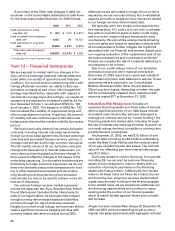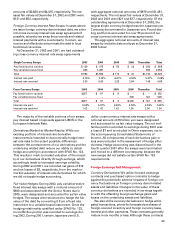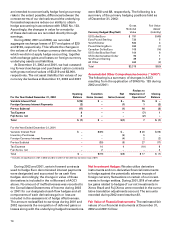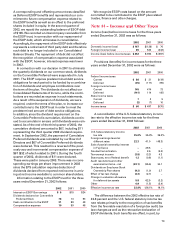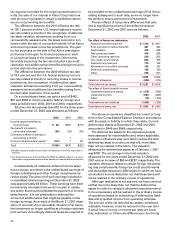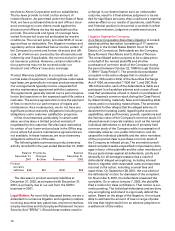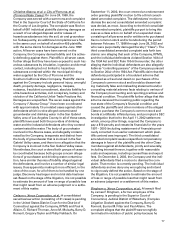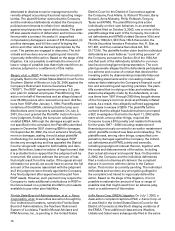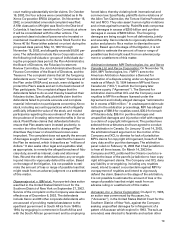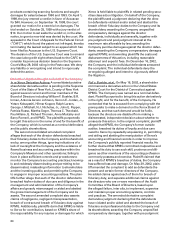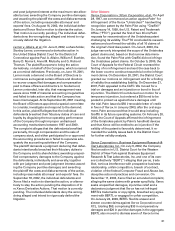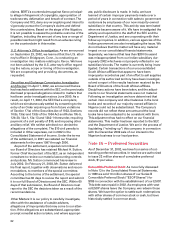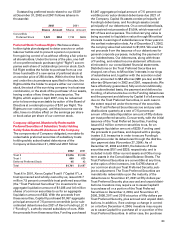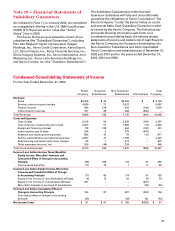Xerox 2002 Annual Report Download - page 79
Download and view the complete annual report
Please find page 79 of the 2002 Xerox annual report below. You can navigate through the pages in the report by either clicking on the pages listed below, or by using the keyword search tool below to find specific information within the annual report.
September 11, 2002, the court entered an endorsement
order granting plaintiffs’ motion to file a third consoli-
dated amended complaint. The defendants’ motion to
dismiss the second consolidated amended complaint
was denied, as moot. According to the third consolidat-
ed amended complaint, plaintiffs purport to bring this
case as a class action on behalf of an expanded class
consisting of all persons and/or entities who purchased
Xerox common stock and/or bonds during the period
between February 17, 1998 through June 28, 2002 and
who were purportedly damaged thereby (“Class”). The
third consolidated amended complaint sets forth two
claims: one alleging that each of the Company, KPMG,
and the individual defendants violated Section 10(b) of
the 1934 Act and SEC Rule 10b-5 thereunder; the other
alleging that the individual defendants are also allegedly
liable as “controlling persons” of the Company pursuant
to Section 20(a) of the 1934 Act. Plaintiffs claim that the
defendants participated in a fraudulent scheme that
operated as a fraud and deceit on purchasers of the
Company’s common stock and bonds by disseminat-
ing materially false and misleading statements and/or
concealing material adverse facts relating to various of
the Company’s accounting and reporting practices and
financial condition. The plaintiffs further allege that this
scheme deceived the investing public regarding the
true state of the Company’s financial condition and
caused the plaintiffs and other members of the alleged
Class to purchase the Company’s common stock and
bonds at artificially inflated prices, and prompted a SEC
investigation that led to the April 11, 2002 settlement
which, among other things, required the Company to
pay a $10 penalty and restate its financials for the years
1997 – 2000 (including restatement of financials previ-
ously corrected in an earlier restatement which plain-
tiffs contend was improper). The third consolidated
amended complaint seeks unspecified compensatory
damages in favor of the plaintiffs and the other Class
members against all defendants, jointly and severally,
including interest thereon, together with reasonable
costs and expenses, including counsel fees and expert
fees. On December 2, 2002, the Company and the indi-
vidual defendants filed a motion to dismiss the com-
plaint. That motion is currently pending. The individual
defendants and we deny any wrongdoing and intend
to vigorously defend the action. Based on the stage of
the litigation, it is not possible to estimate the amount
of loss or range of possible loss that might result from
an adverse judgment or a settlement of this matter.
Bingham v. Xerox Corporation, et al.: A lawsuit filed
by James F. Bingham, a former employee of the
Company, is pending in the Superior Court of
Connecticut, Judicial District of Waterbury (Complex
Litigation Docket) against the Company, Barry D.
Romeril, Eunice M. Filter and Paul Allaire. The
complaint alleges that the plaintiff was wrongfully
terminated in violation of public policy because he
Christine Abarca, et al. v. City of Pomona, et al.
(Pomona Water Cases): On June 24, 1999, the
Company was served with a summons and complaint
filed in the Superior Court of the State of California for
the County of Los Angeles. The complaint was filed on
behalf of 681 individual plaintiffs claiming damages as
a result of our alleged disposal and/or release of
hazardous substances into the soil, air and groundwa-
ter. Subsequently, six additional complaints were filed
in the same court on behalf of another 459 plaintiffs,
with the same claims for damages as the June 1999
action. All seven cases have been served on the
Company, the Company denies liability and it is active-
ly defending against them. Plaintiffs in all seven cases
further allege that they have been exposed to such haz-
ardous substances by inhalation, ingestion and dermal
contact, including but not limited to hazardous
substances contained within the municipal drinking
water supplied by the City of Pomona and the
Southern California Water Company. Plaintiffs’ claims
against the Company include personal injury, wrongful
death, property damage, negligence, trespass,
nuisance, fraudulent concealment, absolute liability for
ultra-hazardous activities, civil conspiracy, battery and
violation of the California Unfair Trade Practices Act.
Damages are unspecified. The seven cases against the
Company (“Abarca Group”) have been coordinated
with approximately 13 unrelated cases against other
defendants which involve alleged contaminated
groundwater and drinking water in the San Gabriel
Valley area of Los Angeles County. In all of those cases,
plaintiffs have sued both the providers of drinking
water and the industrial defendants who they contend
contaminated the water. The body of groundwater
involved in the Abarca cases, and allegedly contami-
nated by the Company, is separate and distinct from
the body of groundwater that is involved in the San
Gabriel Valley cases, and there is no allegation that the
Company is involved in the San Gabriel Valley cases.
Nonetheless, the court ordered both groups of cases to
be coordinated because both groups concern allega-
tions of groundwater and drinking water contamina-
tion, have similar theories of liability alleged against
the defendants, and involve a number of similar legal
issues, thus apparently making it more efficient, in the
view of the court, for all of them to be handled by one
judge. Discovery has begun and no trial date has been
set. Based on the stage of the litigation, it is not possible
to estimate the amount of loss or range of possible loss
that might result from an adverse judgment or a settle-
ment of this matter.
Carlson v. Xerox Corporation, et al.: A consolidated
securities law action (consisting of 21 cases) is pending
in the United States District Court for the District of
Connecticut against the Company, KPMG and Paul A.
Allaire, G. Richard Thoman, Anne M. Mulcahy, Barry D.
Romeril, Gregory Tayler and Philip Fishbach. On
77



